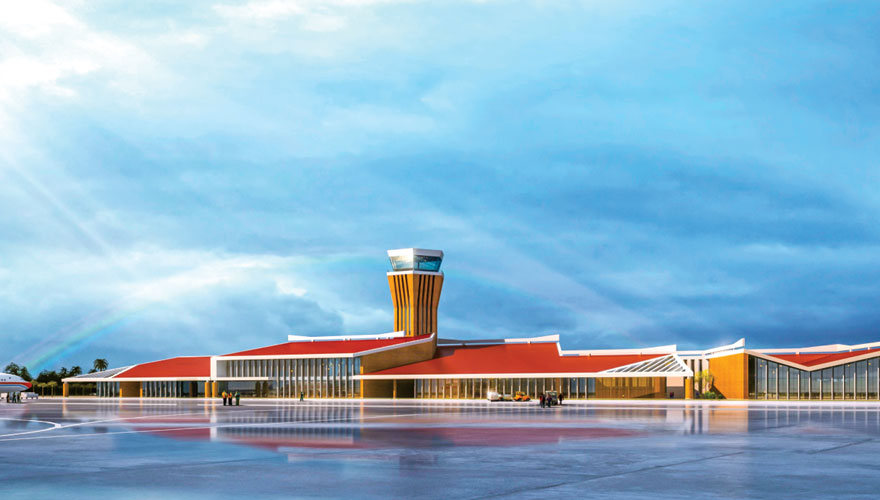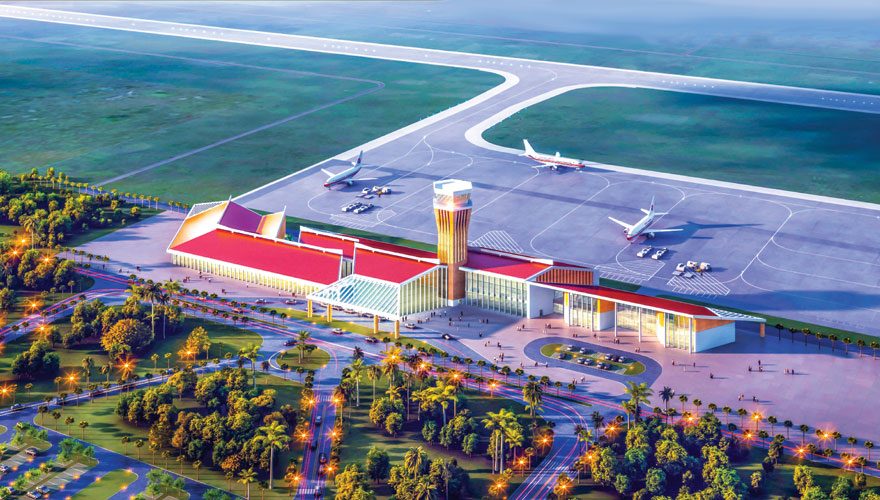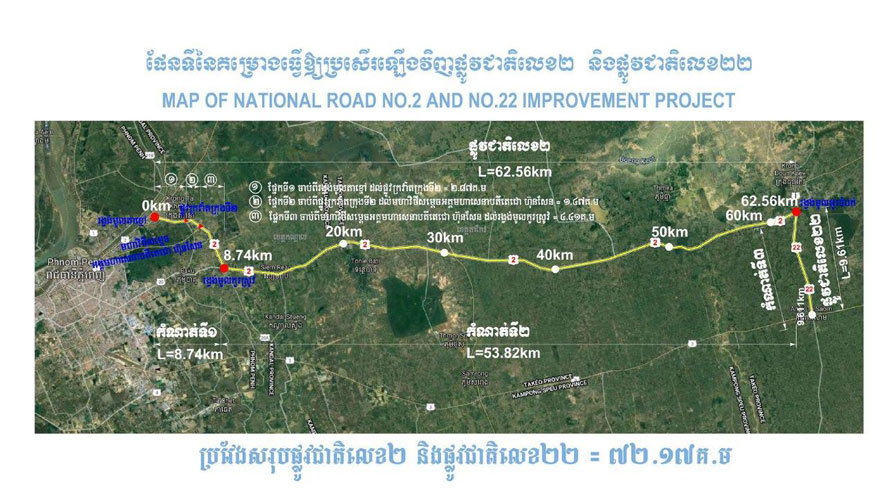There was a time when Cambodia had 15 airports, some of which were built during the Japanese occupation and some in the 1960s. But time and war led to the closure of a majority of them and the buildings becoming derelict, overcome by undergrowth and despair.
For the latest Cambodian Business news, visit Khmer Times Business
Three airports – Siem Reap, Sihanoukville and Phnom Penh – survived the scourge an are now catering to an expanding affluent society and tourism sector.
Owing to rising passenger arrivals, which are expected to nearly double to 18 million in 2034 from 10 million in 2018, new airports are being built in Phnom Penh, Siem Reap and Koh Kong based on public-private partnership models.
Four airports are greenfield developments and one is brownfield. All the airports are on a build-operate-transfer basis pending the expiry of a specified concession period.
Cambodia is experiencing a second spring in airport growth amid a buoyant economy with average expansion of 7 percent year-on-year.
The State Secretariat of Civil Aviation (SSCA) estimates the airport business in Cambodia to be around $3.74 billion while financial commitment to airport infrastructure between 2014 and 2022 amounts to $3.24 billion.
In Southeast Asia, the Asian Development Bank, World Bank and the Organisation for Economic Cooperation and Development claim that national aviation investments worth $800 billion per year is anticipated for 2020.
The expenditure ranges from aircraft leasing, aviation training, maintenance and overhaul (MRO), aeronautical parts manufacturing to construction of access roads to airports.
Paying a small price
In Cambodia, sector growth comes with a small price – that being the entry of Chinese partners in infrastructure development, largely seen as an extension to Beijing’s Belt and Road Initiative.
In Siem Reap, Chinese developer Angkor International Airport Investment (Cambodia) Co Ltd is pouring in nearly $900 million to build the Siem Reap Angkor International Airport, a new facility located 40km from an existing airport operated by Cambodia Airports, formally known as SCA (Societe Concessionnaire des Aeroports) since 2001.
This special purpose vehicle is jointly owned by VINCI Airports SAS and Muhibbah Masteron (Cambodia) JV Ltd on a 70:30 ratio. Muhibbah Masteron is a 70 percent subsidiary of Kuala Lumpur-listed Muhibbah Engineering Berhad whereas VINCI Airports is wholly owned by Paris-listed Vinci SA.
VINCI Airports manages 44 airports in France and abroad under full ownership, concession contracts and/or delegated management.
Cambodia Airports also holds a 45-year build-operate-transfer concession for Phnom Penh International Airport, which it won in 1995, and operates the Sihanoukville International Airport.
In recent years, it spent $100 million to renovate and refurbish all three airports but, on the whole, it has invested $500 million over its two decades of operating presence in Cambodia.
Last year, Cambodia Airports hosted 10.5 million passengers, 5.4 million in Phnom Penh and 4.4 million in Siem Reap while Sihanoukville handled more than 650,000 passengers. The airports serve more than 55 destinations and cater to 700 flights weekly.
According to its financial statement for the first half ending June 30, 2019, (1H19), VINCI Airports’ global operating income rose 38.5 percent to €518 million ($568.9 million) versus €374 million ($410.7 million) last year.
Strong growth in passenger numbers in most of its airports including Cambodia (up 15.5 percent), despite a high base for comparison, pushed up VINCI Airports’ revenue by 8.1 percent to €1.07 billion ($1.17 billion) in the first half this year from €741 million ($813.7 million) in 1H18.
The statement also showed that the Vinci group allocated €45 million ($49.4 million) related to its commitment under the contractual agreement for its Cambodia operations in 1H19. This is higher than its full year allocation of €32 million ($35.1 million) last year.

‘Early stages of talks’
Up until three years ago, Cambodia Airports was the only airport operator in the Kingdom.
With a series of airport construction in Koh Kong, Siem Reap and Phnom Penh by Chinese developers and brand new concessions, the once-exclusive control by Cambodia Airports over the nation’s airports has come under threat.
An aviation expert who declined to be named, alleges that the company’s days as a concessionaire are numbered. In other words the agreement might not be renewed.
“Cambodia Airports might also have to close down its Phnom Penh airport because of the pressure of traffic diversion to the new airport. Even if it becomes a low carrier cost airport, how will they operate and make money with just a few airlines?” the expert asks.
Cambodia Airports’ alleged failure to clinch the Phnom Penh airport project is likely because of the government’s preference for new investment from an investor with no funding constraints.
“The new investor says it is financially able to do it and would hire experts to do the job,” the expert opines.
It comes as no surprise that Cambodia Airports might be somewhat anxious with airports mushrooming all over the country.
But rumours are that it may have a part to play in the new $1.5 billion Phnom Penh International Airport, although in what capacity remains uncertain.
If that does not materialise, the government might negotiate a settlement with Cambodia Airports.
When asked in May about this likelihood, Cambodia Airports declined to comment at “this stage of early talks”.
Breaking even in 12 years
The new airport is farmed out to Cambodia Airport Investment Co Ltd and is 90 percent owned by homegrown Overseas Cambodia Investment Corp (OCIC), with the remaining stake held by the SSCA. It is a public-private partnership in which revenue is based on equity ownership. OCIC expects to break even in 12 years.
About 2,600 hectares of land has been earmarked for the new airport project which is six times larger than the existing airport.
The new airport alone will occupy 700 hectares, about double the footprint of the current airport. The remaining land would be developed into an airport city and mixed-use development of commercial and residential units.
The entire project site is also considerably larger than the Beijing Capital International Airport, the world’s second busiest airport which handled 94 million passengers in 2016. It is located on 1,480 hectares of land.
Reports say the OCIC would allocate $280 million for the new Phnom Penh airport. Public funds would make up $120 million and the rest ($1.1 billion) is expected to be Chinese-funded.
On January 11 last year, OCIC Chairman Pung Kheav Se and Hu Huaibang, chairman of China Development Bank (CDB) signed a financing cooperative framework for the project, sealing talks of China’s role in the development.
Chinese military base?
China’s involvement in local airport infrastructure projects is viewed with scorn in some quarters where people remain sceptical.
In Koh Kong, China-based Union Development Group Co Ltd is spending $200 million for the first phase of Cambodia Dara Sakor International Airport that is expected to be completed by 2025.
The 99-year airport concession is part of the $3.8 billion Dara Sakor Beachside Resort that includes a seaport and mixed development on a 45,000 hectare land.
Critics including the US government claim that the project was allegedly a bid by China to locate a military base. The claim was debunked by Prime Minister Hun Sen, calling the news article that featured the story as “fake and twisting the truth”.
A document seen by Capital Cambodia reveals that the airport, designed by China Aviation Planning and Design Institute (Group) Co Ltd, will be built in four phases.
Phase I, which features a code 4D airport, will cater to Boeing 737s, Airbus 320s, Gulfstream G550s and Bombardiers that meet the needs of cities in Southeast Asia, South Asia, the Middle East and also Europe.
The airport will expand to a 4E and 4F status which would be able to accept long-haul and bigger capacity airplanes in the next 30 years.

“Union Development is the developer or concession holder of the entire project. It has outsourced the construction to third parties, including Chinese companies, because they themselves don’t have the expertise in airport building,” the source adds.
The construction of Terminal 1 is being built by state-owned China Railway Construction International Co Ltd while Sichuan Huaxi Overseas Investment Construction Co Ltd is building a 3.2 kilometre runway, airfield area, apron and fuel farm.
The fire rescue station and airfield drainage is being built by Liaoning Tianhe Airport Construction Co Ltd.
Most of the airport is 80 percent complete while land infrastructure is about 40 percent done, a source tells Capital Cambodia.
Passenger throughput data shows that the Dara Sakor airport would handle 120,000 persons per year by 2025, rising to 750,000 passengers per year by 2030, 4 million per year by 2050 and 50 million by the time phase four is completed.
More airports on the horizon
Not too far from the Dara Sakor airport is the existing domestic Koh Kong Airport which is being upgraded at a cost of $43 million by Bangkok Airways Public Co Ltd.
The Thai-listed company holds a 30-year concession period, which ends in 2048, for the brownfield project by the coast.
In Poipet, locally-owned Poipet Airport Corp is spending $53 million to undertake the greenfield project with a 30-year leasehold. Construction is planned next year.
As the years roll on, revival of old airports or new development is possible as the numbers increase in aircraft, passenger and cargo movements.
In 2018, the SSCA data showed a 16 percent increase in aircraft movements or flight units to 104,803 from 90,200 in 2017.
Air freights climbed 15 percent to 74,665 tonnes in 2018 from 65,000 tonnes a year ago.
By 2022, the Phnom Penh International Airport is expected to add 17 new scheduled airlines with flights to seven new countries. Siem Reap will add 19 new scheduled airlines and Sihanoukville will add 10 new scheduled airlines.
Apart from the three airports that are in operation and four under construction, the SSCA has identified four former operating domestic airports and 11 airfields or airstrips that could be revived one day.
This could raise the total number of airports from the heydays so long as the flight path for Cambodia’s aviation sector remains clear.




